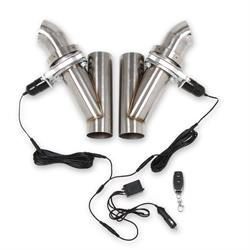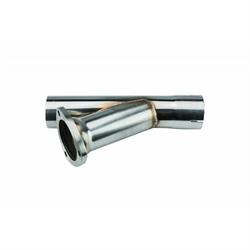Ultimate Guide to Exhaust Cutouts | Manual Cutouts VS Electric
Red light. You pull up to the line and let your engine come down to idle. It sounds good, a nice mellow tone coming from your 2.5 inch exhaust kit, no drone, just a nice low rumble. Then some joker in a little eye-tal-yun sports car rolls up next to you. The driver looks over and with a sneering grin revs the engine, which belts out that high-pitched snarl we all know from European performance cars. You return the favor in kind, which is a substantial bellow, but alas you just lack the roar that you REALLY want. Your mind is made up; you need exhaust cutouts.
There are two reasons for exhaust cutouts. While technically used for race mode when you need to uncork the exhaust for maximum output, we all know why we REALLY want them, to make it known you have a lil’ sumthin-sumthin’ under the hood. We can be honest here; this is a gearhead safe space. Most of us want our cars to sound really good from the outside and fairly quiet on the inside. The days of a couple of 40-series chambered “mufflers” droning on and on at 2,000 rpm should be behind us. Exhaust drone sucks, so once you get into your mid-30s, you want something a little more drivable day to day, but that 20-year-old creeps up sometimes and says “give ’em hell and let er rip.” You can have both.
What Are Exhaust Cutouts?
In the early days of hot rodding, “Lake Pipes” were a required component to any exhaust system. These were side pipes with bolt-on caps that could be unbolted when you were at the drag strip or salt flats (hence the name- derived from the dry lake bed of the salt flats racing). There were a few versions, from the original capped cones on flathead Fords in a Model Ts and As, to the side pipes previously mentioned, and the under-car version that became popular in the 1970s. The problem is that you must get out, and often under the car, to open them. There is a cable-operated valve version, but the cables get rusty quickly and tend to be a bit finnicky. These days, it is all electric.
Most cutouts require some sort of Y-pipe in the exhaust, typically installed before the mufflers, usually just behind the headers or exhaust downpipe from the engine. One side (the straight section of the Y pipe) runs through to the rest of the exhaust system, while the off-shoot branch goes to the cutout. From there, you can use a manual cutout such as a bolt-on clamp or cable-operated valve, but most gearheads go with the electric version for on-the-fly volume adjustment. Electric exhaust cutouts are a bolt-on valve that is controlled by a rocker switch in the car. With this type, you can open them a little or all the way, giving you precise control over the volume of the exhaust.
There is a third type, which is muffler cutouts. Instead of a Y-pipe, the muffler has a second outlet that you can unbolt to free up the exhaust. These also work with electric cutouts.
Why Would You Want Exhaust Cutouts?
Because loud is cool, sometimes. Cruise night? Cool. Driving past a funeral? Not so much. The predominant reason we gearheads want cutouts is for being childish with our loud, rumbly cars, again, this is a safe space for gearheads. The other reason is to unleash more power. Dyno testing has proven repeatedly that a properly designed exhaust system with cutouts unlocks substantial horsepower and torque, essentially the same as running open headers. For example, one YouTube dyno test showed a Big Block Chevy producing 790hp on open headers, 721hp with 3-inch exhaust added, and 782hp with the exhaust cutouts opened. Gaining 69 horsepower is huge. If you are racing, that can be the edge you need to get the win.
For those who live in emissions-controlled states or noise-regulated municipalities where you can’t drive with a louder exhaust that doesn’t have catalytic converters, exhaust cutouts are the primary solution for street/strip cars. Going to the drag strip or road course with a corked-up exhaust hampers your engine’s ability to breathe, opening the cutouts to bypass all that stuff can free up a fair amount of power. Plus, it is loud. Nothing gets a gearhead’s blood pumping quite like the scream of an open exhaust.
Are Exhaust Cutouts Legal?
For off-road use in most states, yes. Highway use, however, is illegal in most states. These laws also state that any muffler louder than the OE muffler is also illegal. So technically, using them on the street is a no-no, but enforcement depends on your local jurisdiction. The key to using them on the street is fairly simple: don’t be the stand-out that makes trouble. An occasional blast of exhaust on a cruise night or the like is usually OK, but making full tilt passes down the street gets the Fuzz called, so exercise caution when using them on the street.
What Are The Best Exhaust Cutouts, Manual or Electric?
By now you have likely ascertained that we think electric valves are the best exhaust cutout option. This is due to their ease of use and quick response- i.e., they close instantly when you REALLY need them closed. Manual exhaust cutouts with cables are certainly similar to electric, but the cable routing can be tricky, and they tend to hang up. Bolt-on exhaust kits might be a good idea if you live in a highly restricted area for exhaust, taking away the temptation to use them on the street.
Electric exhaust cutouts are not perfect, however. The motors can fail and there are wires that you must protect from the exhaust heat. You also must orient the valve so that the motor is not at risk from road debris. We have experienced a motor coming loose and falling off, so make sure the mounting bolts are secured with at least a medium thread locker. You also will have to wire electric exhaust cutouts, which require a relay, fuse, and a three-position momentary rocker switch (like a power window button). Finding the right location for the switch can be tricky in some vehicles. There is a substantial price increase with electric cutouts, as a pair starts at around $500.
What Do I Need To Install Cutouts?
There are several ways to skin this cat. The most common method uses a Y-pipe on each side of the exhaust (talking about dual exhaust), which usually has a 3-bolt flange and cap. You can stop there and just unbolt the system when you want, or upgrade to cable or electric valve options. Adding an electric valve to the flange allows you to open then on the fly. There are several versions of these available from Speedway Motors. You also need a turndown (or build a custom outlet pipe from the Y-pipe to the outside edge of the body) to keep the exhaust fumes and flames (yes, it is possible) heading in the right direction.
The closer to the engine the cutouts are, the more likely you are to get a bit of flamage. If you have dumps right off the headers, you WILL get fire out of the exhaust. You must understand this and ensure that the exhaust from the cutout is routed out from under the vehicle so that you don’t go boom halfway down the strip. Be sure to protect all nearby wiring, as well as fuel, brake, and transmission lines that are in the area of the cutouts. Heatshield sleeving or metal shielding is highly recommended. For maximum drag strip power, locate the cutouts after the headers. For the best sound, position them after your exhaust system’s X or Y-pipe. You may even gain a little handful of horsies, as X/H pipes are a net-positive exhaust component.
Are Exhaust Cutouts Bad For Your Car?
In general terms, no they are not, but it all depends on how you install them. You don’t want the cutouts to be too close to the engine, as this can cause reversion. The cutouts should be at least 18 inches from the cylinder head, preferably a little further downstream so you get the benefit of scavenging. If your engine is fuel injected, then they need to be at least 18 inches from the O2 sensors. Any closer and the sensor readings will be affected, and your engine will not run as well as it should.
Then you get into fumes. Cutouts should not be located under the center of the vehicle where the fumes can gather and leak into the cabin. Instead, the cutout should dump the exhaust as close to the rocker panel as possible with a 90-degree turn down installed on the end. The cutout may be located close to the main exhaust routing, with a fabricated exhaust pipe feeding the gases out from under the body. If you do it this way, you can use the pipe length to tune the engine for maximum efficiency.
Exhaust Cutout Installation Tips
The best exhaust designs use H or X pipes to balance the exhaust, yielding better tone and enhancing the scavenging effect. You can install the cutout before or after the balance pipe. By mounting the cutouts AFTER the X or H pipe you get to take advantage of the balance pipe, which can drastically alter the power output and tone. H-pipes tend to have a raspier “muscle car” rumble, whereas X-pipes usually have a more balanced, roaring note. Think typical late-model Corvette (X-pipe roar) and Fox-body Mustang (H-pipe raspiness). With a cutout, you get that same effect, but louder.
Are Exhaust Cutouts Worth It?
When it comes to performance, the answer is clear, exhaust cutouts work and are absolutely worth the effort. For street driving, it lets you add a little more rumble (or scream) when you want it, and a nice, quiet, neighborhood-friendly exhaust note when you don’t. Considering that C6 Corvettes had an optional remote-controlled exhaust valve from the factory shows that yes, you really do “need” a set of cutouts. Some high-performance vehicles are using similar exhaust valves to tune the engine in real time, such eco-mode, sport-mode, etc. to not only make the engine run economically, but also get the power boost when you want it. Get in your garage and install set, you will LOVE them.






